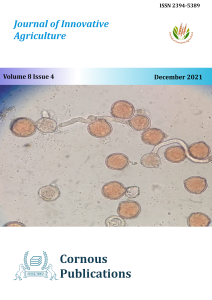
Journal of Innovative Agriculture
Peer Reviewed Open Access Journal
ISSN: 2394-5389 NAAS Rate: 4.05
Submit Manuscript
Peer Reviewed Open Access Journal
ISSN: 2394-5389 NAAS Rate: 4.05
Submit ManuscriptTen malt barley genotypes were evaluated in randomized complete block design with three replications under farmers’ participatory selection scheme at four locations in western Shoa, Central Ethiopia during 2019 main cropping season. The objectives of this experiment were to select superior malt barley varieties in the study area and to identify farmers’ preference and selection criteria. Farmers’ set; number of kernels per spike, tillers per plant and plumpness as selection criteria at maturity stage of the crop. The results of the combined analysis of variance indicated highly significant differences among genotypes for all traits tested at 1% probability level. The GXE interaction also showed highly significant differences for all characters at 1% probability level, except grain yield which was significant at 5% probability level. The highest mean grain yield was obtained from the genotype HB-1963 (3528 Kg ha-1) whereas the lowest from the variety Sabini (2057 Kg ha-1). Farmers’ evaluation of direct matrix ranking showed HB-1963 (score 40) and IBON-174/03 (score 32) were the most preferred genotypes and Traveller (score 16) the least one. Therefore, the genotypes HB-1963 and IBON-174/03 were chosen for their performance in the experimental field and also acceptable from farmers' participatory evaluation. Thus, based on the results of this study and previous information from the evaluation of the varieties, the selected varieties need to be popularized, multiplied and distributed to farmers.
participatory, malt barley, tillers per plant, kernels per spike
Ahmed, I. A., El-Hag, A. A., Amer, K. A., El-Moselhy, M. A., & Said, M. A. (2001). Evaluation of some barley genotypes for salt tolerance. In National Coordination Meeting, Egypt, ARC, Cairo, Sept (pp. 2-4).
Asfaw, Z. (2000). The barleys of Ethiopia. Genes in the field: On-farm conservation of crop diversity, 77-108.
Bellon, M. R. (2007). Crop research to benefit poor farmers in marginal areas of the developing world: a review of technical challenges and tools. CAB Reviews: Perspectives in Agriculture, Veterinary Science, Nutrition and Natural Resources, 1(70), 1-11.
Ceccarelli, S., & Grando, S. (2002). Plant breeding with farmers requires testing the assumptions of conventional plant breeding: Lessons from the ICARDA barley program. Farmers, scientists and plant breeding: Integrating knowledge and practice, 297332.
Ceccarelli, S., & Grando, S. (2009). Participatory plant breeding. In Cereals (pp. 395-414). New York, NY: Springer US.
Ceccarelli, S., Grando, S., & Booth, R. H. (1996). International breeding programmes and resource-poor farmers: Crop improvement in difficult environments. In Workshop on Participatory Plant Breeding, Wageningen (Netherlands), 26-29 Jul 1995. IPGRI.
Ceccarelli, S., Grando, S., Shevstov, V., Vivar, H., Yayaoui, A., El-Bhoussini, M., & Baum, M. (1999). The ICARDA strategy for global barley improvement. Rachis, 18(2), 3-12.
CSA., (2017). Central Statistics Authority Report on Area and Production of Crops. Agricultural Sample Survey, Addis Ababa, Ethiopia.
De Boef, W. S., & Thijssen, M. H. (2007). Participatory tools working with crops, varieties and seeds. A guide for professionals applying participatory approaches in agrobiodiversity management, crop improvement and seed sector development. Wageningen UR Centre for Development Innovation.
FAO., (2005). Food and Agriculture Organization of the United Nations. Estimates of world production and harvested area.
Gomez, K. A., & Gomez, A. A. (1984). Statistical procedures for agricultural research. John Wiley & Sons.
Mariey, S. A., Mohamed, M. N., Khatab, I. A., El-Banna, A. N., Khalek, A. F. A., & Al-Dinary, M. E. (2013). Genetic diversity analysis of some barley genotypes for salt tolerance using SSR markers. Journal of Agricultural Science, 5(7), 12.
Yetsedaw, A., Tadesse, D., & Wondimu, B. (2010). Participatory Evaluation of malt barley (Hordiumvulgare L.) Genotypes for yield and other agronomic traits at North-west Ethipoia. Wudpecker J. Agric. Res, 2(8), 218-222.
